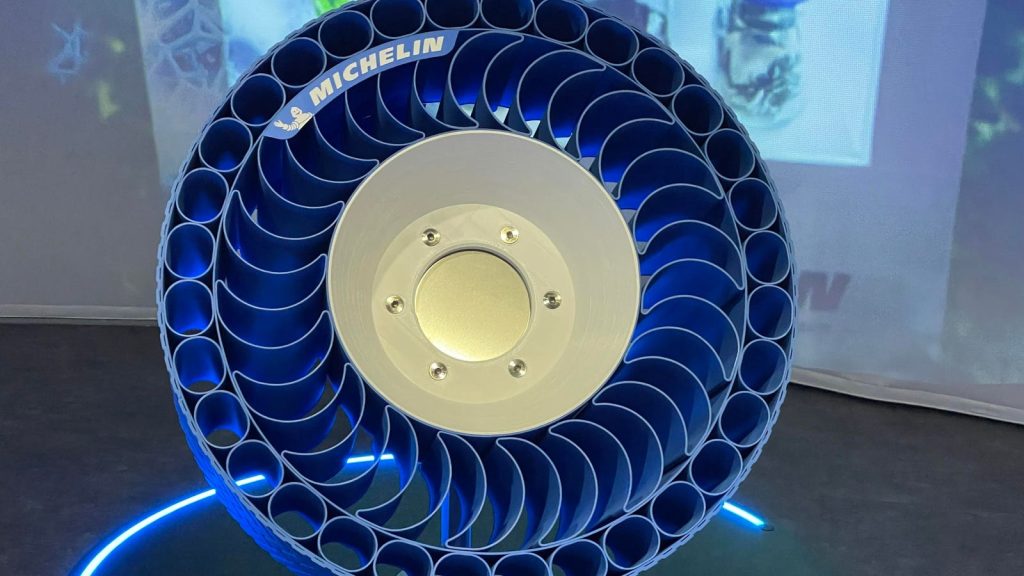We’re moving into an electric vehicle transition, but pneumatic tires feel constant. Invented in 1888 by Dunlop but championed in the auto industry from 1891 onwards by Michelin, inflatable rubber has been improved considerably since then. But the basic concept of tires has persisted for well over a century. Now, according to Michelin, this could be the time for a new type of tire, which has been mooted for as much as decade – with no inflation involved.
The addition of air to car tires has arguably been essential for the widespread adoption of mechanized transport. Suspension and shock absorbers can only go so far delivering the ride quality and handling we require in a modern vehicle. The air in tires has provided an extra cushion to soften the experience for car occupants and maintain vehicle stability. The side effect is also that less road noise is transferred into the car.
However, while there have been some incremental improvements over the years, the radial pneumatic tire that Michelin invented as far back as 1940, going on sale in 1972, remains the primary technology. Seeing that this was an area that might need updating, Michelin unveiled the UPTIS (Unique Puncture-Proof Tire System) at the 2019 Movin’On Summit. But the idea goes back further than that. Over ten years ago Polaris produced an ATV that came equipped with airless tires, because they were so much more resilient to offroad damage.
Michelin Airless Tires In Space?
Ten years later, Michelin is convinced that airless tires will be essential to mobility and improving environmental impact, although still with no timeframe about when. At the Le Mans 24 Hours race in June, the company showed off an airless design it had created to meet NASA’s brief for the Artemis program’s moon rover. It is obvious why airless tires might be preferable when driving on the airless surface of the moon. But they have plenty of benefits for less extraterrestrial applications as well, on a surface with a breathable atmosphere.
One issue with pneumatic tires is punctures – a particular problem with the UK’s horrendously potholed roads. In fact, 20% of tires around the world end up being removed before their typical lifespan is reached. This isn’t just from potholes but can be caused by irregular wear due to them being pumped to the wrong pressure. This results in the replacement of 1 – 1.6 billion tires per year – a phenomenal issue for the environment, that has been further accentuated by the move to EVs.
This is one area where the switch to airless tires could help. They can’t be set to the wrong pressure, because they don’t have any air inside them. This prevents that form of damage, and they’re more resilient to other types of impairment too. Pneumatic tires can be harmed in a way that doesn’t cause deflation, but risks it, meaning they will need to be replaced for safety reasons. For example, sidewall damage might not immediately puncture the tire but compromises the structural integrity. In the UK, this is usually an MOT fail necessitating replacement. However, current airless designs don’t even have sidewalls. Damage to the sprung fins is still possible, but Michelin argues that this is quite unlikely and won’t lead to catastrophic failure like a pneumatic tire blowout.
The lifespan of an airless tire could be further extended through retreading. This is something that has been practiced for over a century. It’s common practice for large commercial vehicles like trucks and buses, but not for cars, due to tire size and complexity. Car tires are expected to deliver high performance, such as coping with road speeds well more than 100mph. There is also a consumer perception that this would not be safe, nor would the shorter lifespan of the rest of the tire make this kind of repair economical. However, it’s estimated that airless tires could last up to three times longer than pneumatic ones, potentially enduring between 50,000 and 100,000 miles, depending on driving conditions and maintenance. This could make retreading them more economical than pneumatic car tires. A good quality all-season car tire lasts between three and five years or 20,000 to 60,000 miles – but as already mentioned, it may end up being replaced long before this due to damage.
Is The Michelin Tire Future Airless?
Airless tires require further material innovation over pneumatic ones. The exterior tread will be made of similar rubber to traditional wheels, but the complex internal structure that replaces the pressurized air is generally manufactured from polyurethane reinforced by glass fiber. The rim will remain aluminum, steel or an alloy, but it may be a more integral part of the wheel, so the airless tire can’t be removed. It’s unlikely that the weight resistance will be adjustable, in the way that we inflate our tires more when carrying a heavy load. The airless tire will need to be calibrated against the maximum weight the car is rated to carry.
Aside from the lunar vehicle prototype revealed at Le Mans, Michelin has been road testing its UPTIS airless tires with La Poste in France and with DHM in Singapore. Tesla has also been reported to be in talks with Michelin to use the company’s airless tires in its cars. However, Michelin admits that there are still no standards about airless tires in the same way that pneumatic ones are rated. Alongside Michelin’s UPTIS, Bridgestone has an Air Free Concept, and Hankook has the iFlex. Goodyear has ventured even further into science fiction with its spherical Eagle 360 Urban concept for autonomous cars. But in general, most tire manufacturers are not prioritizing airless just yet. Still, there are clear benefits from airless tires, so they could soon be another step towards making transport more eco-friendly.
Read the full article here










